
Takasago stable is a stable of sumo wrestlers, one of the Takasago group of stables. It is correctly written in Japanese as "髙砂部屋", but the first of these kanji is rare, and is more commonly written as "高砂部屋".

Miyabiyama Tetsushi is a former sumo wrestler from Mito, Ibaraki, Japan. A former amateur champion, he turned professional in 1998. With the exception of two tournaments, he was ranked in the top division of professional sumo from 1999 until the end of his career in 2013, holding the second highest rank of ōzeki from 2000 to 2001. He won eight special prizes and was runner-up in four top division tournaments. He wrestled for Fujishima stable, where he worked as a coach until opening his own Futagoyama stable.
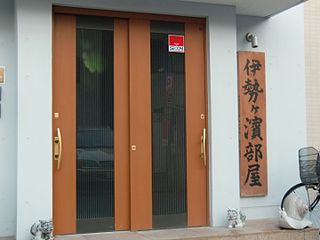
Isegahama stable, formerly known as Ajigawa stable from 1979 to 2007, is a stable of sumo wrestlers, part of the Isegahama ichimon or group of stables. Its current head coach is former yokozuna Asahifuji.
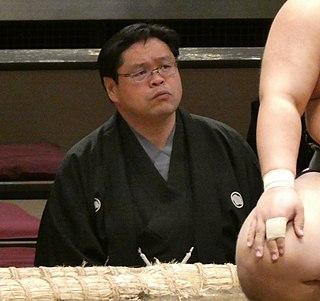
Tochinonada Taiichi is a former sumo wrestler from Ishikawa Prefecture, Japan. An amateur sumo champion, he turned professional in 1996 and reached the top makuuchi division in 1997. He earned twelve kinboshi or gold stars for defeating yokozuna, the second highest ever, and he was a runner-up in two tournaments. His highest rank was sekiwake. He is now a coach at Kasugano stable under the name Takenawa Oyakata.

Tamakasuga Ryōji is a former sumo wrestler from Seiyo, Ehime Prefecture, Japan. A former amateur sumo champion, he made his professional debut in 1994 and reached a highest rank of sekiwake in 1997. He fought in the top makuuchi division for twelve years, won five special prizes and earned seven gold stars for defeating yokozuna. He retired in 2008 and is now a sumo coach. In February 2010 he took over the running of Kataonami stable.

Takekaze Akira is a former professional sumo wrestler from Akita Prefecture, Japan. A former amateur sumo champion, he turned professional in 2002, reaching the top makuuchi division the following year. He was a runner-up in one tournament, earned two special prizes for Fighting Spirit, and one gold star for defeating a yokozuna. Takekaze is in first place for the slowest promotion from makuuchi debut to the third highest sekiwake rank in history. Aged 35 years and two months, he is in first place for the eldest to make his sekiwake debut post World War II. He was a member of Oguruma stable. He retired in January 2019 to become an elder of the Japan Sumo Association under the name Oshiogawa-oyakata.
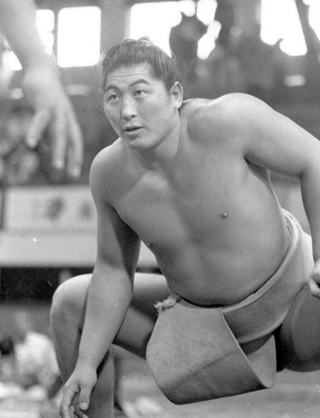
Kiyokuni Katsuo is a former sumo wrestler from Ogachi, Akita, Japan. His highest rank was ōzeki, which he held from 1969 to 1974. He won one top division yūshō or tournament championship and was a runner-up in five other tournaments. He also earned seven special prizes and seven gold stars. After his retirement he was the head coach of Isegahama stable.

Kataonami stable is a stable of sumo wrestlers, part of the Nishonoseki ichimon or group of stables. It was founded in 1961 by former sekiwake Tamanoumi Daitarō, who branched off from Nishonoseki stable. Former sekiwake Tamanofuji took over the running of the stable upon Tamanoumi's death in 1987. In February 2010 he passed control over to another former sekiwake, Tamakasuga, remaining in the stable under the elder name Tateyama. As of January 2023 it had four active wrestlers. The March 2023 tournament saw the first promotion to the jūryō division for the stable since the former Tamakasuga took over as head coach, with Tamashōhō becoming its first new sekitori since Tamawashi in January 2008.
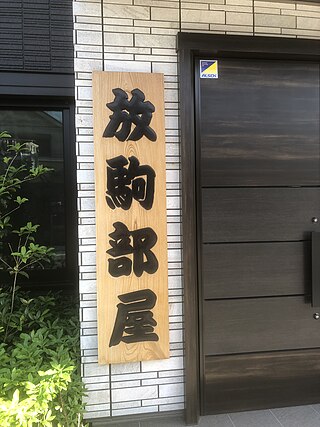
Hanaregoma stable, formerly known as Matsugane stable and Nishonoseki stable, is a stable of sumo wrestlers. It was founded in 1990 as Matsugane stable by Wakashimazu who branched out from the Futagoyama stable. It has produced five top makuuchi division wrestlers; Wakakoshō (2000), Wakatsutomu (2001), Harunoyama (2004), Shōhōzan (2011) and Ichiyamamoto (2021). After the retirement of Harunoyama in November 2006 the stable had no sekitori until Shōhōzan reached the jūryō division in March 2010. As of January 2023 it had 8 wrestlers.
Fujinokawa Takeo is a former sumo wrestler from Otofuke, Hokkaido, Japan. He made his professional debut in May 1961 and reached a highest rank of sekiwake in May 1967. He was a runner-up in two top division (makuuchi) tournaments, finishing three wins behind Tamanoshima in May 1968 and losing a playoff to ozeki Kiyokuni in July 1969. He earned four kinboshi for defeating yokozuna and won seven special prizes. After his retirement in 1972 at the age of 26 he became an elder of the Japan Sumo Association and took over as head coach of Isenoumi stable in 1982. He left the Sumo Association in 2011 upon reaching 65 years of age.
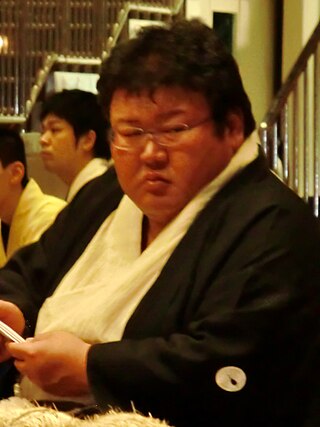
Daishōyama Naoki is a former sumo wrestler from Anamizu, Ishikawa, Japan. A former amateur champion, he made his professional debut in January 1989 and reached a highest rank of maegashira 2 before retiring in 1995. He is now the head coach of Oitekaze stable.
The following are the events in professional sumo during 2009.
The following are the events in professional sumo during 2006.
The following are the events in professional sumo during 2000.
Ōzutsu Takeshi is a former sumo wrestler from Mie, Japan. Beginning his professional career in May 1971, he was ranked in the top makuuchi division continuously from March 1979 to January 1992, and his record of 1170 consecutive bouts there is the second best in history after Takamiyama. His highest rank was sekiwake. He was runner-up in one tournament and earned ten kinboshi or gold stars for defeating yokozuna. He also won four sanshō or special prizes. He wrestled for Taihō stable and after his retirement in May 1992 he worked there as a coach before leaving the Japan Sumo Association in 2008.
The following are the events in professional sumo during 2010.
The following are the events in professional sumo during 2011.
Dewanohana Yoshitaka is a former sumo wrestler from Nakasato, Aomori, Japan. He made his professional debut in July 1974, and reached the top division in November 1977. His highest rank was sekiwake. He retired in January 1988 and became an elder in the Japan Sumo Association under the name Dekiyama. Upon reaching the mandatory retirement age of 65 in May 2016 he was re-hired by the Sumo Association for five years as a consultant.

Wakasegawa Yoshimitsu was a sumo wrestler from Sakata, Yamagata, Japan. He made his professional debut in 1978, reaching the top makuuchi division for the first time in 1983. His highest rank was maegashira 1. He retired in 1992 and worked in the restaurant business after leaving sumo.

Isegahama stable was a heya or stable of sumo wrestlers, part of the Tatsunami-Isegahama ichimon, or group of stables.














